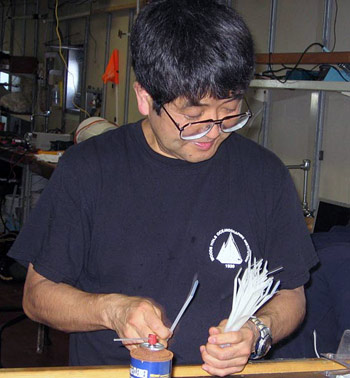Interview with Ko-ichi Nakamura
by Dan Conrad

What is your area of research?
My current research is in marine geology, specializing in hydrothermal vent systems. There are two kinds of vents, hot systems and cold seeps. They both involve fluid discharging on the ocean floor. Cold vents typically give off methane and hydrogen sulfide. Hot vents discharge hydrogen sulfide and other gases, like CO2, also methane, and hydrogen.
You are on a cruise designed to develop AUV technology. Do they have capabilities you need for your research?
In 1980, when I started in marine science, even the ship’s position at sea was not well fixed. Today, the ship runs SeaBeam, which continuously maps the sea floor contours in a swath along the path of the ship.
After World War II, echo sounding was the new technology, replacing the method of sounding with a weight on a line. In 1994, when I first sailed on the Knorr, they had a military GPS unit. It was in a special box in the radio room, with a lock that would scramble its decoding facility if anyone tampered with it. This is how new and secret GPS was then, and that was just 13 years ago! Now, of course, GPS is on cars. The advance in ocean science technology has been very great in recent years, and the AUV is the up-and-coming technology.
How do you see AUVs benefiting the kind of research you do?
An AUV is not like an ROV that can gather samples of rocks and fluid, but the AUV has advantages.
The research does not depend only on samples. There are other factors – details where AUVs can help. Although the ship can map a vent site using SeaBeam, the resolution is not very good and sometimes you cannot see the individual vents. Mapping from an AUV can improve the resolution by at least ten times.
The ship and other vehicles (human-occupied vehicles and remotely operated vehicles) require a large amount of support from the ship for each dive, and there is only one of them, so they can make only one pass over a site at a time. As AUV technology develops, multiple vehicles will be able to cover much greater areas with less cost.
Since an AUV cannot gather samples, what data can it gather for you?
I am particularly interested in the Eh electrode, or redox sensor. This sensor was originally developed for monitoring in atomic energy plants, but I use them to find hydrothermal vents. I make the Eh sensors that I use for my research because the application is different.
What is an Eh sensor?
It is an electrochemical device that compares the voltage difference between an electrode made of inert metal (platinum), which is in the seawater environment, and a silver/silver chloride electrode, which is placed in a silver chloride solution, and acts as a standard. Many people are familiar with pH, which measures the presence of hydrogen ions. The Eh sensor responds to all ions and indicates how chemically reactive a fluid might be. Hydrothermal waters contain chemicals, like hydrogen sulfide, that make the Eh decrease in value.
An Eh sensor is easy for an AUV to carry. When the vehicle moves through the plume of a vent, the pH does not change significantly, but there can be a dramatic shift in the Eh level. And the greater the signal becomes, the closer you are to a vent.
It is interesting to understand the research you are doing a little better.
Now can you tell about yourself? Where were you born and where did you study?
I was born in Japan and I studied in Japan – I now work at the National Institute of Advanced Industrial Science and Technology in Tsukuba, Japan.
My early interest was in volcanoes. This led to marine geology, and this in turn led to study of seismic refraction in the 1980’s. In 1988, I was studying volcanoes in a subduction zone south of Japan when I discovered a high temperature vent system. Such systems had been found only in ridge areas of tectonic spreading before my discovery. I used Japanese deep submergence vehicles for some of this research and went to the bottom of the ocean.
How did you come to be on this cruise?
I was invited to participate. In 1992, I started working with the Eh sensor as a way to detect high temperature vents without having to gather samples. This is a good match with the AUV research at WHOI. And my research over the years has attracted attention.
Do you go on many cruises?
I have averaged about three a year since the late 1990’s; sometimes two, sometimes four.
How could a young person get into this kind of work?
Well, for me there were many times when I was fortunate to have good opportunities. I would just say that a person should use his/her best ability and follow their interests.
[Back
to top]
|
